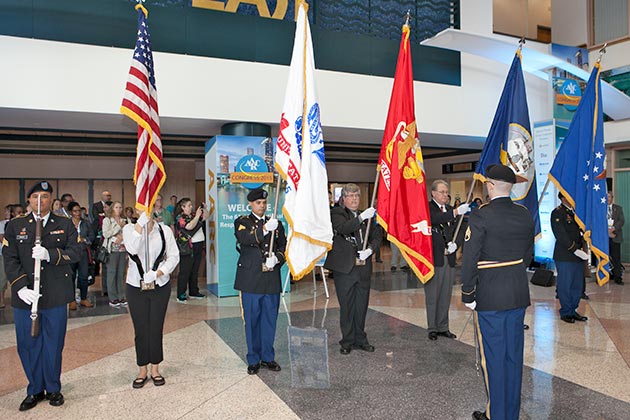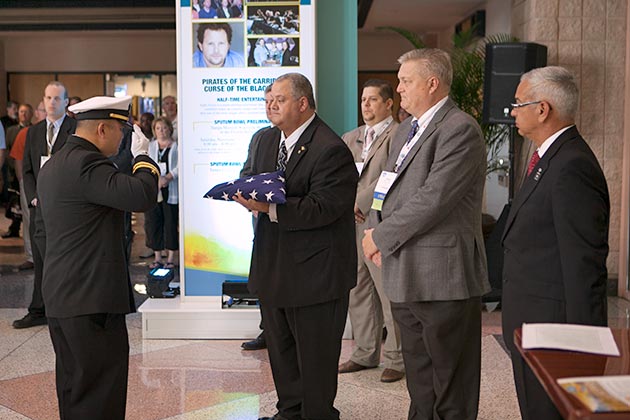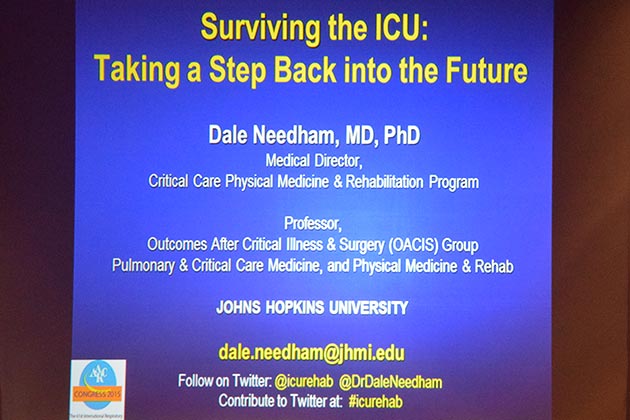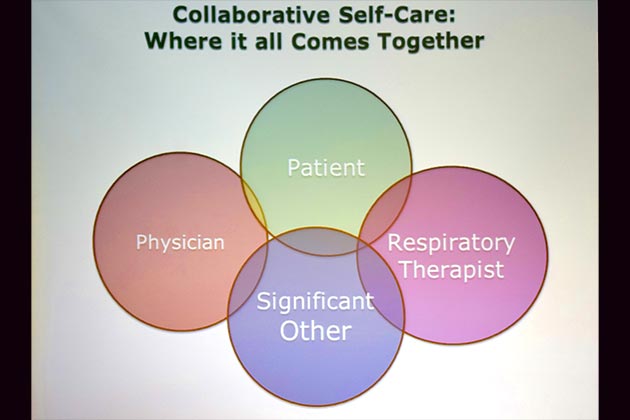Congress-goers party down after first day of meeting

There was so much going on during the first day of the Congress that attendees had a hard time keeping up with what they wanted to do and when.
But everything mellowed out last night as Congress-goers flocked to the Marriott for the Opening Reception sponsored by Draeger. With entertainment by DJ2Live and complimentary drinks and snacks, it proved to be the perfect place to unwind after a long day of sessions — as well as network with friends and colleagues, new and old alike.
Officials installed, President Salvatore outlines goals
The Association’s 2016 officials were installed during this morning’s AARC Annual Business Meeting. Brian Walsh MBA RRT-NPS FAARC was installed as president-elect, and other officers include Lynda Goodfellow EdD RRT FAARC vp-internal affairs; Cynthia White MSc RRT-NPS FAARC vp-external affairs; and Karen Schell DHSc RRT-NPS RPFT secretary-treasurer.
Our 2016 directors include Cheryl Hoerr MBA RRT CPFT FAARC (Management Section); Ellen Becker PhD RRT-NPS FAARC (Education Section); Keith Lamb BS RRT-ACCS (Adult Acute Care Section); Natalie Napolitano MPH RRT-NPS FAARC (Neonatal-Pediatrics Section); Kimberly Wiles BS RRT CPFT (Home Care Section), and at-large directors, Billy Lamb BS RRT FAARC; Timothy Op’t Holt EdD RRT FAARC, and Lisa Trujillo DHSc RRT.
Three Specialty Sections also held elections this year, and these individuals were elected: Zach Gantt RRT (Home Care); Marilyn Barclay BS RRT CPFT (Sleep), and Steve Sittig RRT-NPS C-NPT FAARC (Neonatal-Pediatrics).
In his address to the group, AARC President Frank Salvatore Jr MBA RRT FAARC went over his goals for office, with a special emphasis on a three-pronged approach to advancing the respiratory therapist beyond the traditional care settings.
“For too long, respiratory therapists have had very defined and very few paths to take,” he told the audience. Over the next year he plans to work more closely with like-minded groups and organizations to create the backing and support he believes is necessary to move the profession forward on this front. He also plans to “make available and encourage research that continues to show the value of respiratory therapists to the outcomes of our patients in all care settings.”
The final prong in the approach will be support for the Medicare Telehealth Parity Act, which will be the focus of the 2016 PACT trip up Capitol Hill. “There are many advantages to having RTs be a part of this approach to health care, because in the long run it, helps the most important person to our profession — the pulmonary patient,” said Salvatore.
Here are Salvatore’s 2015–2016 presidential goals:
- Continue to develop and execute strategies that will increase membership beyond 50,000 active members and participation in the AARC both nationally and internationally.
- Promote activities to increase public awareness of respiratory therapists and their role in the diagnosis and treatment of respiratory disorders.
- Advance the concepts and initiatives brought about by the “Respiratory Therapist for 2015 and Beyond” conferences. Develop a toolkit to ensure the existing educational programs are able to move in a direction that will allow them to continue to develop our future students at a level that is consistent with them obtaining a bachelor’s degree, which will eventually become the entry into our profession.
- Promote and advocate for appropriate patient and caregiver access to respiratory therapists in all care settings through local, state, and national legislation, regulation, and/or policies including, but not limited to, recognizing respiratory therapists outside the traditional health care venues as well as recognizing the credential of registered respiratory therapist (RRT) as the minimum requirement for licensure.
- Continue to advance our international respiratory community presence through activities designed to address issues affecting educational, medical, and professional trends in the global respiratory care community and to advance advocacy for the patient.
- Promote the access of high quality continuing education for the development and enhancement of the skill base of today’s practitioners to meet the current and future needs of our profession.
- Encourage the development of programs, accreditation, and credentialing of the advanced practice respiratory therapist (APRT) as a level of practice that will further improve the care given to our patients and advance the career track of our profession.
- Maintain and expand relevant communication and alliances with key allies and organizations within our communities of interest.
Expand efforts to obtain research funding and develop the next generation of respiratory therapy researchers. The American Respiratory Care Foundation (ARCF) is an integral part of the funding/fundraising related to research; we will increase participation by our membership in ARCF fundraising activities through an educational effort that will increase awareness of the importance of the ARCF.
A Veteran’s Day salute

Veteran’s Day may still be a few days away, but Congress-goers got a head start on the celebrations this morning with a flag-folding ceremony honoring those among us who are serving in our armed forces today and those who have so willingly given of their service in the past.
A “Passing the Boot” was held, for which monies collected will go towards the Combat Wounded Veteran Challenge. A special roll call also took place for Thomas Wallsmith, the only RT known to have been killed in the line of duty, and Dr. Forrest Bird, who served so bravely in World War II and was our oldest living member until his death earlier this year. Other colleagues we lost this year will be honored as well.

Special thanks to these AARC members and veterans of service for taking part in the ceremony: Steven Sittig RRT-NPS C-NPT FAARC; James Wood RRT; Douglas Masini RRT-NPS FCCP FAARC; John Hiser MEd RRT FAARC; Chelby Mathison RRT-NPS CPFT; Harry Roman MA RRT 1SG Retired; MAJ Wadie Williams Jr MS RRT; LT Joseph Buhain EdD RRT FAARC; SGT Myra Roman RRT; SSG Crispin St John RRT; SGT Michael Romero CRT; SPC Monica Campbell CRT; SPC Aaron Meehan CRT; SPC Billy Pierce RRT; SGT Edward Wadey CRT; SPC Sherita Lee CRT; SPC William Mason CRT; 2LT Kayla Bunn RN; 1LT Minerva Arzon RN; 1LT Daisy Mailhot RN, SSG Seth Moulton, RRT. Thanks also to Jim Doepke for serving as the bugler for the event.
Thomas L. Petty Memorial Lecture —
You Want Me to Do What?

Back in the day, hospitals got their patients up and about as soon as possible, but with the advent of sophisticated critical care modalities capable of saving even severely ill or injured patients, that’s no longer the norm in the ICU.
Dale Needham, MD, PhD, believes it’s time to go back to the future — even if that means getting a mechanically ventilated patient in the ICU on his feet and moving with the help of a team of health care professionals, including RTs.
In this morning’s Thomas L. Petty Memorial Lecture, the professor of pulmonary and critical care medicine and medical director of the critical care physical medicine and rehabilitation program at Johns Hopkins explained how ICU-acquired weakness (ICUAW) can devastate a patient both in the short and long term.
According to the physician, the problem lies in the usual trajectory followed in modern ICUs. Clinicians focus on the patient’s immediate problems and put the brain, the nerves, and the muscles on the backburner. Patients are left under heavy sedation and it is not until the patient’s primary problems resolve that rehabilitation comes into the picture. By then the patient is so weak he is typically discharged to a rehab center.
Studies suggest that’s too late. Nearly half of patients in one trial had neuromuscular abnormalities a year later and another found only half of those of working age had been able to return to work.
One trial that used a variety of methods to measure muscle loss found significant loss occurs in mechanical ventilator patients within just days of being intubated, and these losses occurred independent of nutrition. “So just feeding them better is not going to work,” said Needham.
What does work, he continued, is to implement an early mobility program similar to the one he and his colleagues have put into place at Johns Hopkins. In a study they conducted to gauge long-term outcomes among their patients, they found only two factors were associated with long-term muscle weakness — age and bedrest. For each additional day of bedrest there was an 8-11% decrease in muscle strength that persisted over two years.
You can’t do anything about age, said Dr. Needham, but bedrest is a modifiable risk factor.
“We need an ICU where patients are animated and motivated,” emphasized the physician. He and his colleagues embarked on a quality improvement project aimed at implementing early mobilization in ICU patients, with results showing the concept was both safe and effective. The program involves a multidisciplinary team including PTs, OTs, and RTs who work with physicians, nurses, and others to get the patient out of bed and moving.
Another study that looked at their outcomes over 2.5 years found use of narcotics was cut by two-thirds without an increase in patient pain, the number of ICU days without delirium doubled, and ICU mortality dropped by 10%. ICU length of stay declined by 30% and hospital length of stay by 18%.
Dr. Needham illustrated the human side of these gains by sharing the case of one patient who had been deemed ventilator dependent for life by another physician. He and his team got the man up and walking and within two weeks he was able to walk 240 feet while still on the ventilator. A photo showing the man finally getting to go outside brought applause from the audience, as did the news that he was eventually weaned from the ventilator.
Dr. Needham said the patient came back to visit the ICU staff trailing his oxygen — and then proceeded to tell them that he felt so good he didn’t even have it turned on.
A short film of another patient talking about his experiences with the early mobility program at Johns Hopkins left the audience inspired as well. Said this gentleman, “I thought it was wonderful … anything to get me up on my feet. This is what I wanted to do.”
Congress to-do list

Making the most of a meeting as big as the AARC Congress takes a little advanced planning. These tips can help you maximize your experience —
- Budget time after sessions to visit with lecturers and ask questions. All the lecturers at this meeting (even the biggest names here) will be available after their talks to speak directly with attendees.
- Network with your colleagues to learn more about what they’re doing at their facilities and explore job opportunities around the country.
- Use social media to spread the word to your colleagues, both at the meeting and back home, about what you’re learning — and find out what they are doing too. It’s a great way to connect with old friends and colleagues whom you might not even know are here. #aarc15!
- Pick up all the handouts you’re offered, even if you don’t see a use for them right now. It never hurts to have more information than you need.
- Collect business cards of the folks you meet and jot down notes on the back of the cards to remember who’s who and why they may be important to your future.
- Use the Congress to explore new career paths. All of the Specialty Sections and many of the Roundtables are hosting meetings, and everyone (not just current members) is invited to attend.
- Set aside time each day to visit the Exhibit Hall and make a list of the vendors you want to see during each excursion — or even better, use our AARC Mobile event app to plot out your visit. Remember, the hall is open today through Monday, so you don’t have to see it all at once.
- Ask vendors to share the scientific proof behind their new technologies and inquire about opportunities to conduct joint research projects.
- Take advantage of vendor-sponsored events and be sure to request follow-up calls or visits from vendors once you get back home.
New Horizons targets monitoring
Treating patients without monitoring them for the results of that treatment is akin to driving while blind. In this year’s New Horizons Symposium, experts in various forms of monitoring will take the podium to share the latest advances in this technology. Sessions will focus on everything from recent embellishments to pulse oximetry and volumetric capnography, to the use of ultrasound to evaluate the lungs and diaphragm, electrical impedance tomography, and monitoring during procedural sedation. The symposium kicks off this afternoon at 1:45 and runs till 5.
Educating the educators
The AARC Respiratory Patient Advocacy Summit held on Friday pointed up the value chronic lung disease patients put on patient education.
The AARC debuted a new educational course earlier this year aimed at bringing more RTs up to speed on cutting-edge patient education techniques. The Pulmonary Disease Educator Course was designed with input from the Allergy and Asthma Network: Mothers of Asthmatics, COPD Foundation, American Association of Cardiovascular and Pulmonary Rehabilitation, Pulmonary Fibrosis Foundation, and Cystic Fibrosis Foundation and covers all the bases when it comes to helping chronic lung patients better understand how to treat and manage their conditions.
Look for additional sessions of this live course to be announced in early 2016.
Secretary-Treasurer’s Report
Karen Schell DHSc RRT-NPS RPFT
Your professional organization is in good fiscal shape. Although the U.S. economy has been somewhat up and down this year, the AARC continues to be served by a fiscally responsible Executive Office and Board of Directors. Some of the 2015 highlights are:
- Membership: Our number of members has not grown as we would have liked. Nonetheless, with your dues and all other revenues we continue to provide the programs and services that are important to you. This includes providing high quality educational programs and working with all levels of government to assure that you are appropriately recognized for what you do.
- Revenues: Our revenues are holding their own overall thanks to your continued support via membership dues, educational course offerings, and attendance at meetings such as the International Respiratory Convention & Exhibition.
- Grants: Includes grants from two large Corporate Partners. One is in a more mature phase and not billing as much in 2015 vs. 2014.
- Expenses: Our actual expenses for 2015 are below budget for the year at this time. The AARC officers and Executive Office staff take very seriously the trust you have placed in us and will always strive to spend your money wisely.
Thanks to each and every one of you for making this another successful year for the AARC. And thank you for the opportunity to serve as your secretary-treasurer for the past 11 months.
Are You Ready to Expand Your PR Services Outside of the Traditional Program?

Pulmonary rehabilitation is getting a new lease on life, thanks in part to government penalties now in place for excessive readmissions for COPD. In fact, in some places the idea of expanding these services into areas outside of the traditional program is being raised.
In a talk that took place this morning, Trina Limberg, BS, RRT, FAARC, MAACVPR, shared her take on what PR programs need to consider before embarking on such an expansion.
According to the director of pulmonary rehabilitation services for the University of California San Diego Health System, it begins by assessing the foundation of your program. Supportive leadership, physician involvement, and collaborative partners are among the many factors that should figure into the decision.
So is your front office, emphasized the manager. More patients means more paperwork, and you need enough staff to handle it because your RTs will be handling more patients with more clinical needs and won’t have the time.
From there the program must take a careful look at the resources and staff competencies that would be required and determine whether or not expanding would be beneficial for both the clinicians on staff and the program as a whole. It’s also important, noted Limberg, to make sure your PR staff really want to expand because they are going to be the ones delivering the additional services in the additional areas.
It’s important to consider how you are going to recover costs for the areas in which you expand as well. Limberg emphasizes the PR codes will not work in clinic settings because they only apply when the patient is exercising.
Creative thinking will be needed. For example, if your therapists are seeing neuromuscular disease patients in an outpatient clinic, perhaps their services can be recharged by the neurology department.
If expansion does seem right for your program, the next question to ask is, where can your skill set lend to improvement in care and outcomes? With national readmission rates for COPD currently at about 22.6%, Limberg believes PR clinicians can have a big impact by working with acute care providers, outpatient clinics, and Accountable Care Organizations.
The main goal is to overcome three key breakdowns common today – communication breakdowns between care providers when patients are in transition, patient education breakdowns that leave patients and families with conflicting information, and accountability breakdowns resulting in no one taking responsibility for the coordination of the patient’s care across various settings and providers.
Limberg cited recent recommendations from the ATS/ERS as support for the premise of taking PR to acute care. For example, the two organizations now believe interval training may be as effective as continuous training, meaning that even short bursts of exercise of up to one minute can be considered in patients during their critical and acute care admissions.
Telemonitoring opportunities are becoming increasingly available as well.
Expanding PR services beyond the traditional PR program has paid off for her department at UC San Diego, said Limberg. Thanks to a greater presence of her PR staff in areas outside of the department, PR referrals are up 48% and clinic visits have steadily climbed as well. “We run rehab five days a week and have never been busier,” she said.
At the end of her talk, Limberg asked her audience what they want their programs to look like this time next year. She believes the answer has to be based on what services they want to provide and what volume they think they can handle.
Come Together: Collaborative Care Must Involve the Patient Too

Health care reform is quickly changing the nation’s health care system from one driven by providers alone to one seeking greater involvement from the patient himself.
This patient-centric, collaborative care model is considered paramount to gaining control of costs and improving outcomes, and Kent Christopher, MD, RRT, FAARC, from the University of Colorado Health Sciences Center in Denver, CO, provided a great overview of the concept in an introductory talk to a symposium this afternoon that looked at coordinated care in settings across the continuum.
According to the physician and therapist, proposed regulatory changes released just a couple of days ago would require providers to place a greater emphasis on the patient’s goals and treatment preferences in the discharge process and are likely to ramp up these efforts.
“Now we have to think, what does the patient want,” said Dr. Christopher.
The proposed changes specifically call for providers to begin the discharge process within 24 hours of admission. Everything from the patient’s perspectives on the location of discharge to his or his caregiver’s ability to perform self-care will be taken into account. Utilization of the multidisciplinary team – and the physician said that will mean respiratory therapists too – is emphasized, as is the need for patient education and written instructions on post-discharge care.
Under these rules, hospitals and post-acute care providers would be required to share data and would be judged on quality and resource measures as well.
Dr. Christopher went on to share findings from studies that have been conducted on the components of collaborative, patient-centric care, including one that looked at the role of a care transition coach in meeting the needs of chronic respiratory patients. That study showed a drop in rehospitalizations among patients in the intervention group, and patients themselves reported increased confidence in and understanding of their self-management abilities and plan. A meta-analysis of studies on integrative disease management for COPD patients found equally positive results.
He believes it all hinges on the interactive discussion and sees a significant role for the respiratory therapist in that process.
“In the typical patient encounter, the clinician asks direct, specific questions, the patient attempts to briefly answer, the clinician makes an assessment, plan, or recommendations, and care is delivered,” said Dr. Christopher. “Interactive discussion is minimal to none.”
Asking more open ended questions designed to get the patient to talk about his condition and treatment and establish a real connection with his health care provider is the answer and he believes respiratory therapists can use their expertise to take advantage of educational moments and lift their patients’ spirits.
“When you go in to see a hospitalized patient, do you stand over the bed?” he asked. Better to sit down, look the patient in the eye, smile, and then ask the kind of questions that will encourage the patient to tell you what his needs are.
When the patient raises questions the therapist can’t answer, the therapist should simply defer to the physician – and then give the physician a call letting him know those questions need to be addressed to ensure a smooth transition.
Getting from here to there for RTs and everyone else involved in the patient’s care will require providers to build a team approach to care with an effective game plan based on the medical evidence, concluded Dr. Christopher. Silos need to be eliminated and everyone needs to work together for the good of the patient. “If the team isn’t talking to each other, you’re not going to be very effective for the patient.
Dr. Christopher said compassion should be the overriding principle. “At the end of the day, before you go home, ask yourself this question,” he advised. “Are you simply a health care provider, or are you a caring health care provider?”
NIV: To Use, or Not to Use?

Noninvasive positive pressure ventilation (NIV) has clear advantages over invasive mechanical ventilation in patients with COPD and congestive heart failure (CHF). But is this form of ventilation right for every patient? Brady Scott, MSc, RRT-ACCS, FAARC, delved into that topic this afternoon with a closer look at what the medical evidence has to say about using NIV in patients with other pulmonary issues.
“In reality, we do use it for patients other than COPD and CHF,” said the assistant professor and director of clinical education at Rush University in Chicago, IL. “We need to see what the data say.”
He specifically addressed the use of NIV post-extubation, in patients who are immunocompromised, in those with ARDS and asthma, in those receiving palliative care, as a method of pre-oxygenation prior to intubation, and in those with acute respiratory failure due to chest trauma.
Scott began by citing studies showing post-extubation NIV has been found effective in patients with COPD and may also benefit those with neuromuscular diseases. One meta-analysis involving 16 trials on respiratory failure in intubated adults, for example, suggested a weaning strategy including NIV may reduce mortality and ventilator-associated pneumonia without increasing the risk for weaning failure or reintubation.
But not all studies have been favorable, with another finding no differences in extubation failure or ICU or hospital mortality for NIV when compared to standard medical therapy.
Scott believes the literature is pretty clear: routine NIV after extubation cannot be recommended in all patients and early application following extubation in COPD is probably best. He also believes patients who aren’t doing well on NIV should be promptly intubated. “We need to quit dragging our feet and just hoping the patient will turn the corner.”
The research on immunocompromised patients is somewhat conflicting as well, continued Scott. While two studies involving a small number of patients found those on NIV vs. oxygen therapy had lower rates of intubation and mortality, another published just this October in JAMA found no differences between the two therapies.
Scott did note, however, that two-fifths of the “standard oxygen therapy” patients in the latter study were receiving high-flow nasal oxygen, and that could have limited the ability to show a favorable effect for NIV. “I believe high flow nasal cannula offers a little bit more than standard oxygen therapy alone,” he said.
Scott went on to review two studies on NIV in ARDS that showed a lower intubation rate in the NIV group and improved survival, and a third that found an 85% failure rate for NIV among the patients who received it as an initial therapy. The third study, however, involved very sick patients with H1N1 ARDS, which he believes may explain the high failure rate.
Another study conducted among acute pancreatitis patients who developed ARDS concluded the therapy may be an effective option for some patients, but should be prudently applied.
When it comes to asthma, Scott said the role for NIV has yet to be clearly defined, although studies have suggested the therapy can help decrease the need for invasive mechanical ventilation and even prevent acute respiratory failure in patients without a substantial impairment of gas exchange. “I think the use of noninvasive in asthma is growing and people are having success with it,” said Scott.
He went on to share a case study published in respiratory care that he believes points to the need for careful monitoring at the bedside when NIV is used with asthma patients, noting NIV is not a “set it and leave it” therapy but rather one that must be monitored and changed as the patient’s condition changes.
When it comes to the use of NIV in palliative care patients, Scott said the jury is definitely still out, with little research to show whether or not it prolongs life or extends the dying process, or provides support to patients and families during the end of life.
A study that compared preoxygenation with NIV vs. bag-valve-mask before intubation, however, did suggest benefits for NIV, with fewer oxyhemoglobin desaturations during intubation and higher oxyhemoglobin saturation at the end of preoxygenation, during intubation, and five minutes later in the NIV group.
Another study conducted in those with acute respiratory failure due to chest trauma found NIV led to a significant reduction in the intubation rate, overall complication rate, and infections, although no mortality advantage was seen vs. CPAP.
The key to the successful use of NIV in many patients, continued Scott, is to understand the risk factors for NIV failure, and he went over a list of factors he believes clinicians can use to guide their decisions as they consider application of the therapy in their patients.
He concluded by saying that while “noninvasive ventilation appears to have a place outside of COPD and CHF, clearly we need more data to best understand how and when to use it in other disease processes.” Whenever it is used, close monitoring and titration of settings is crucial.
And that, he emphasized, is “the respiratory therapist’s role.”
